Characteristics of Advection Fog at Qingdao Liuting International Airport
Abstract
:1. Introduction
2. Data and Methods
2.1. Surface Observation
2.2. Sounding Data
2.3. Reanalysis Data
3. Results
3.1. Fog Characteristics under Southeasterly and Northwesterly Winds
3.2. Why the CF Was Thicker Than the EF
3.3. Formation Mechanism and Diurnal Variation of Fog
3.3.1. Moisture Source Is Affected by Surface Heat Flux and Advective Transport
3.3.2. Night/Early Morning Fog Formation Mechanisms
4. Discussion
5. Conclusions
Author Contributions
Funding
Institutional Review Board Statement
Informed Consent Statement
Data Availability Statement
Acknowledgments
Conflicts of Interest
References
- Tardif, R.; Rasmussen, R.M. Event-Based Climatology and Typology of Fog in the New York City Region. J. Appl. Meteorol. Climatol. 2007, 46, 1141–1168. [Google Scholar] [CrossRef]
- Roux, B.; Potts, R.; Siems, S.; Manton, M. Towards a Better Understanding of Fog at Perth Airport. J. Hydrol. 2021, 600, 126516. [Google Scholar] [CrossRef]
- Lu, C.; Niu, S.; Tang, L.; Lv, J.; Zhao, L.; Zhu, B. Chemical Composition of Fog Water in Nanjing Area of China and Its Related Fog Microphysics. Atmos. Res. 2010, 97, 47–69. [Google Scholar] [CrossRef]
- Wang, Y.; Lu, C.; Niu, S.; Lv, J.; Jia, X.; Xu, X.; Xue, Y.; Zhu, L.; Yan, S. Diverse Dispersion Effects and Parameterization of Relative Dispersion in Urban Fog in Eastern China. J. Geophys. Res. Atmos. 2023, 128, e2022JD037514. [Google Scholar] [CrossRef]
- Wang, S.; Yi, L.; Zhang, S.; Shi, X.; Chen, X. The Microphysical Properties of a Sea-Fog Event along the West Coast of the Yellow Sea in Spring. Atmosphere 2020, 11, 413. [Google Scholar] [CrossRef]
- Gultepe, I.; Heymsfield, A.J.; Fernando, H.J.S.; Pardyjak, E.; Dorman, C.E.; Wang, Q.; Creegan, E.; Hoch, S.W.; Flagg, D.D.; Yamaguchi, R.; et al. A Review of Coastal Fog Microphysics During C-FOG. Bound.-Layer Meteorol. 2021, 181, 227–265. [Google Scholar] [CrossRef]
- Fernando, H.J.S.; Gultepe, I.; Dorman, C.; Pardyjak, E.; Wang, Q.; Hoch, S.W.; Richter, D.; Creegan, E.; Gaberšek, S.; Bullock, T.; et al. C-FOG: Life of Coastal Fog. Bull. Am. Meteorol. Soc. 2021, 102, E244–E272. [Google Scholar] [CrossRef]
- Niu, S.; Lu, C.; Yu, H.; Zhao, L.; Lü, J. Fog Research in China: An Overview. Adv. Atmos. Sci. 2010, 27, 639–662. [Google Scholar] [CrossRef]
- Zhang, S.-P.; Xie, S.-P.; Liu, Q.-Y.; Yang, Y.-Q.; Wang, X.-G.; Ren, Z.-P. Seasonal Variations of Yellow Sea Fog: Observations and Mechanisms. J. Clim. 2009, 22, 6758–6772. [Google Scholar] [CrossRef]
- Liu, J.; Sun, Y.; Yang, L. Interannual Variability in Summertime Sea Fog over the Northern Yellow Sea and Its Association with the Local Sea Surface Temperature. J. Geophys. Res. Atmos. 2021, 126, e2020JD034439. [Google Scholar] [CrossRef]
- Gultepe, I.; Isaac, G.A.; Williams, A.; Marcotte, D.; Strawbridge, K.B. Turbulent Heat Fluxes over Leads and Polynyas, and Their Effects on Arctic Clouds during FIRE.ACE: Aircraft Observations for April 1998. Atmosphere-Ocean 2003, 41, 15–34. [Google Scholar] [CrossRef]
- Lee, E.; Kim, J.-H.; Heo, K.-Y.; Cho, Y.-K. Advection Fog over the Eastern Yellow Sea: WRF Simulation and Its Verification by Satellite and In Situ Observations. Remote Sens. 2021, 13, 1480. [Google Scholar] [CrossRef]
- Koračin, D.; Dorman, C.E.; Lewis, J.M.; Hudson, J.G.; Wilcox, E.M.; Torregrosa, A. Marine Fog: A Review. Atmos. Res. 2014, 143, 142–175. [Google Scholar] [CrossRef]
- Yang, L.; Liu, J.-W.; Ren, Z.-P.; Xie, S.-P.; Zhang, S.-P.; Gao, S.-H. Atmospheric Conditions for Advection-Radiation Fog over the Western Yellow Sea. J. Geophys. Res. Atmos. 2018, 123, 5455–5468. [Google Scholar] [CrossRef]
- Liu, L.; Wang, X.; Li, Y.; Wei, W. The Effect of Sea Surface Temperature on Relative Humidity and Atmospheric Visibility of a Winter Sea Fog Event over the Yellow-Bohai Sea. Atmosphere 2022, 13, 1718. [Google Scholar] [CrossRef]
- Gao, X.; Gao, S.; Li, Z.; Wang, Y. A Revised Method with a Temperature Constraint for Assimilating Satellite-Derived Humidity in Forecasting Sea Fog over the Yellow Sea. Front. Earth Sci. 2023, 10, 992246. [Google Scholar] [CrossRef]
- Jin, G.; Gao, S.; Shi, H.; Lu, X.; Yang, Y.; Zheng, Q. Impacts of Sea–Land Breeze Circulation on the Formation and Development of Coastal Sea Fog along the Shandong Peninsula: A Case Study. Atmosphere 2022, 13, 165. [Google Scholar] [CrossRef]
- Fu, G.; Guo, J.; Xie, S.-P.; Duan, Y.; Zhang, M. Analysis and High-Resolution Modeling of a Dense Sea Fog Event over the Yellow Sea. Atmos. Res. 2006, 81, 293–303. [Google Scholar] [CrossRef]
- Gao, S.; Lin, H.; Shen, B.; Fu, G. A Heavy Sea Fog Event over the Yellow Sea in March 2005: Analysis and Numerical Modeling. Adv. Atmos. Sci. 2007, 24, 65–81. [Google Scholar] [CrossRef]
- Li, P.; Fu, G.; Lu, C. Large-Scale Environmental Influences on the Onset, Maintenance, and Dissipation of Six Sea Fog Cases over the Yellow Sea. Pure Appl. Geophys. 2012, 169, 983–1000. [Google Scholar] [CrossRef]
- Zhang, S.; Ren, Z.; Liu, J.; Yang, Y.; Wang, X. Variations in the Lower Level of the PBL Associated with the Yellow Sea Fog-New Observations by L-Band Radar. J. Ocean Univ. China 2008, 7, 353–361. [Google Scholar] [CrossRef]
- Wang, Y.; Gao, S.; Fu, G.; Sun, J.; Zhang, S. Assimilating MTSAT-Derived Humidity in Nowcasting Sea Fog over the Yellow Sea. Weather Forecast. 2014, 29, 205–225. [Google Scholar] [CrossRef]
- Yang, Y.; Gao, S. The Impact of Turbulent Diffusion Driven by Fog-Top Cooling on Sea Fog Development. J. Geophys. Res. Atmos. 2020, 125, e2019JD031562. [Google Scholar] [CrossRef]
- Yang, Y.; Hu, X.-M.; Gao, S.; Wang, Y. Sensitivity of WRF Simulations with the YSU PBL Scheme to the Lowest Model Level Height for a Sea Fog Event over the Yellow Sea. Atmos. Res. 2019, 215, 253–267. [Google Scholar] [CrossRef]
- Zhang, Z.; Li, Y. Spring Planetary Boundary Layer Structure and Corresponding Cloud Characteristics under Different Prevailing Wind Directions over the Kuroshio Sea Surface Temperature Front in the East China Sea. J. Geophys. Res. Atmos. 2020, 125, e2020JD034006. [Google Scholar] [CrossRef]
- Zhang, Z.; Li, Y.; Song, W. Stratocumulus in the Cold and Warm Sides of the Spring Kuroshio Sea Surface Temperature Front in the East China Sea. J. Geophys. Res. Atmos. 2020, 125, e2019JD032176. [Google Scholar] [CrossRef]
- Li, Y.; Yan, J.; Sui, X. Tropospheric Temperature Inversion over Central China. Atmos. Res. 2012, 116, 105–115. [Google Scholar] [CrossRef]
- Hersbach, H.; Bell, B.; Berrisford, P.; Hirahara, S.; Horányi, A.; Muñoz-Sabater, J.; Nicolas, J.; Peubey, C.; Radu, R.; Schepers, D.; et al. The ERA5 Global Reanalysis. Q. J. R. Meteorol. Soc. 2020, 146, 1999–2049. [Google Scholar] [CrossRef]
- Li, Y.; Gu, H. Relationship between Middle Stratiform Clouds and Large Scale Circulation over Eastern China. Geophys. Res. Lett. 2006, 33, L09706. [Google Scholar] [CrossRef]
- Li, Y.; Zhang, M. Cumulus over the Tibetan Plateau in the Summer Based on CloudSat–CALIPSO Data. J. Clim. 2016, 29, 1219–1230. [Google Scholar] [CrossRef]
- Sun, G.; Li, Y.; Li, S. The Differences in Cloud Vertical Structures between Active and Break Spells of the East Asian Summer Monsoon Based on CloudSat Data. Atmos. Res. 2019, 224, 157–167. [Google Scholar] [CrossRef]
- Lu, C.; Liu, Y.; Niu, S.; Endo, S. Scale Dependence of Entrainment-Mixing Mechanisms in Cumulus Clouds: Scale Dependence of Mixing Mechanisms. J. Geophys. Res. Atmos. 2014, 119, 13877–13890. [Google Scholar] [CrossRef]
- Gao, S.; Lu, C.; Liu, Y.; Mei, F.; Wang, J.; Zhu, L.; Yan, S. Contrasting Scale Dependence of Entrainment-Mixing Mechanisms in Stratocumulus Clouds. Geophys. Res. Lett. 2020, 47, e2020GL086970. [Google Scholar] [CrossRef]
- Wood, R.; Bretherton, C.S. On the Relationship between Stratiform Low Cloud Cover and Lower-Tropospheric Stability. J. Clim. 2006, 19, 6425–6432. [Google Scholar] [CrossRef]
- Lin, D.; Katurji, M.; Revell, L.E.; Khan, B.; Osborne, N.; Soltanzadeh, I.; Kremser, S. Fog Type Classification Using a Modified Richardson Number for Christchurch, New Zealand. Int. J. Climatol. 2023, 43, 314–330. [Google Scholar] [CrossRef]

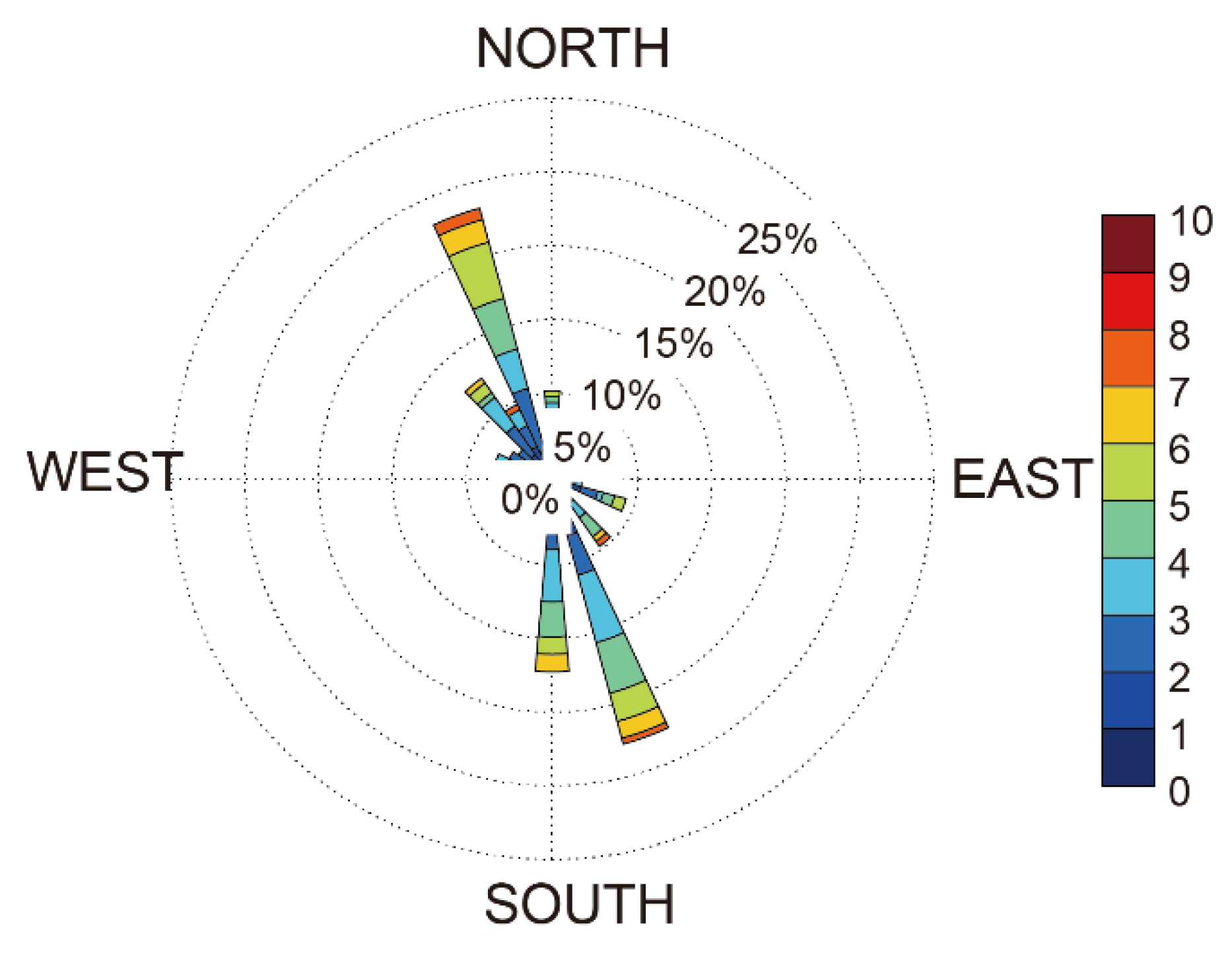
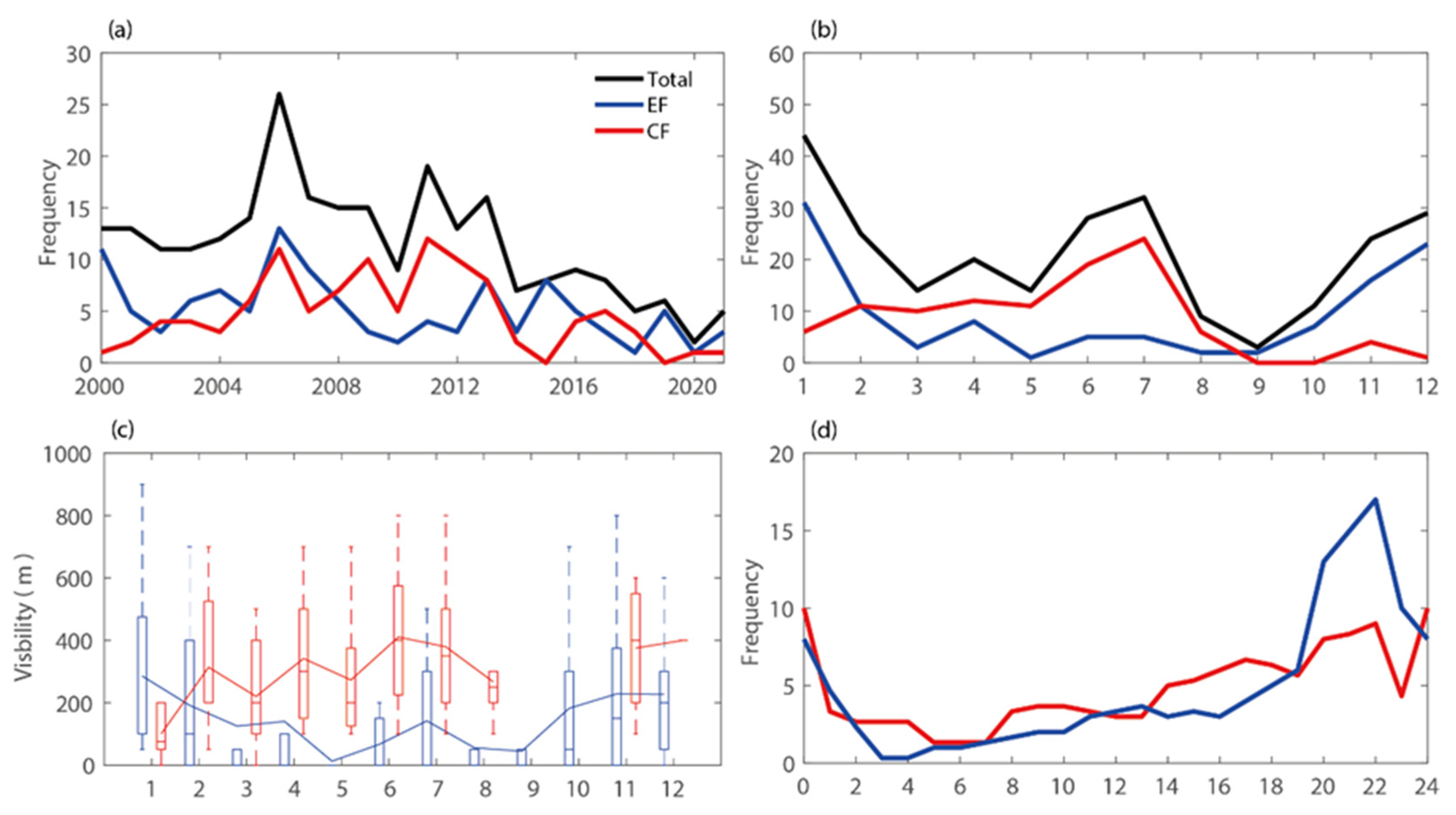
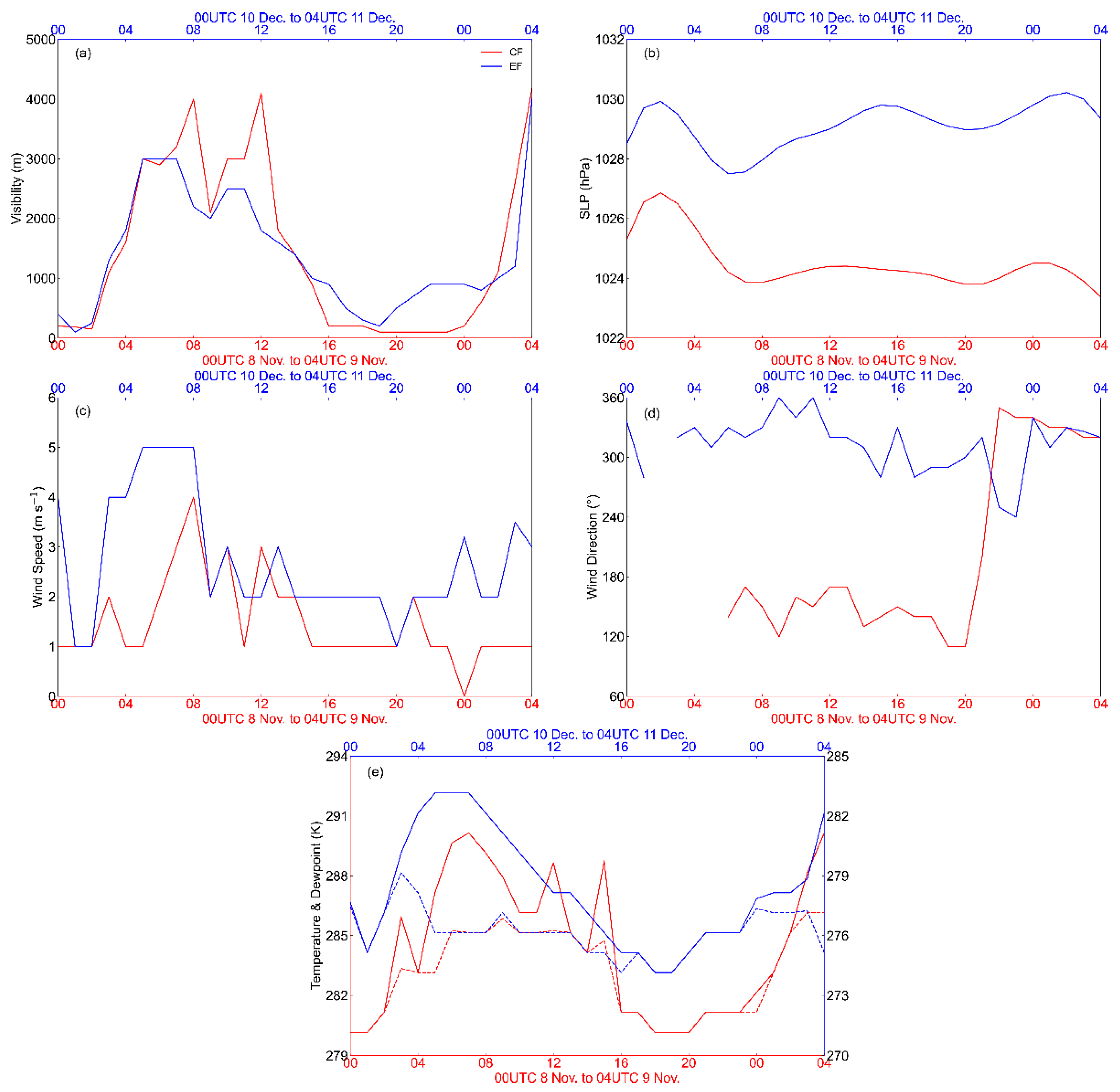
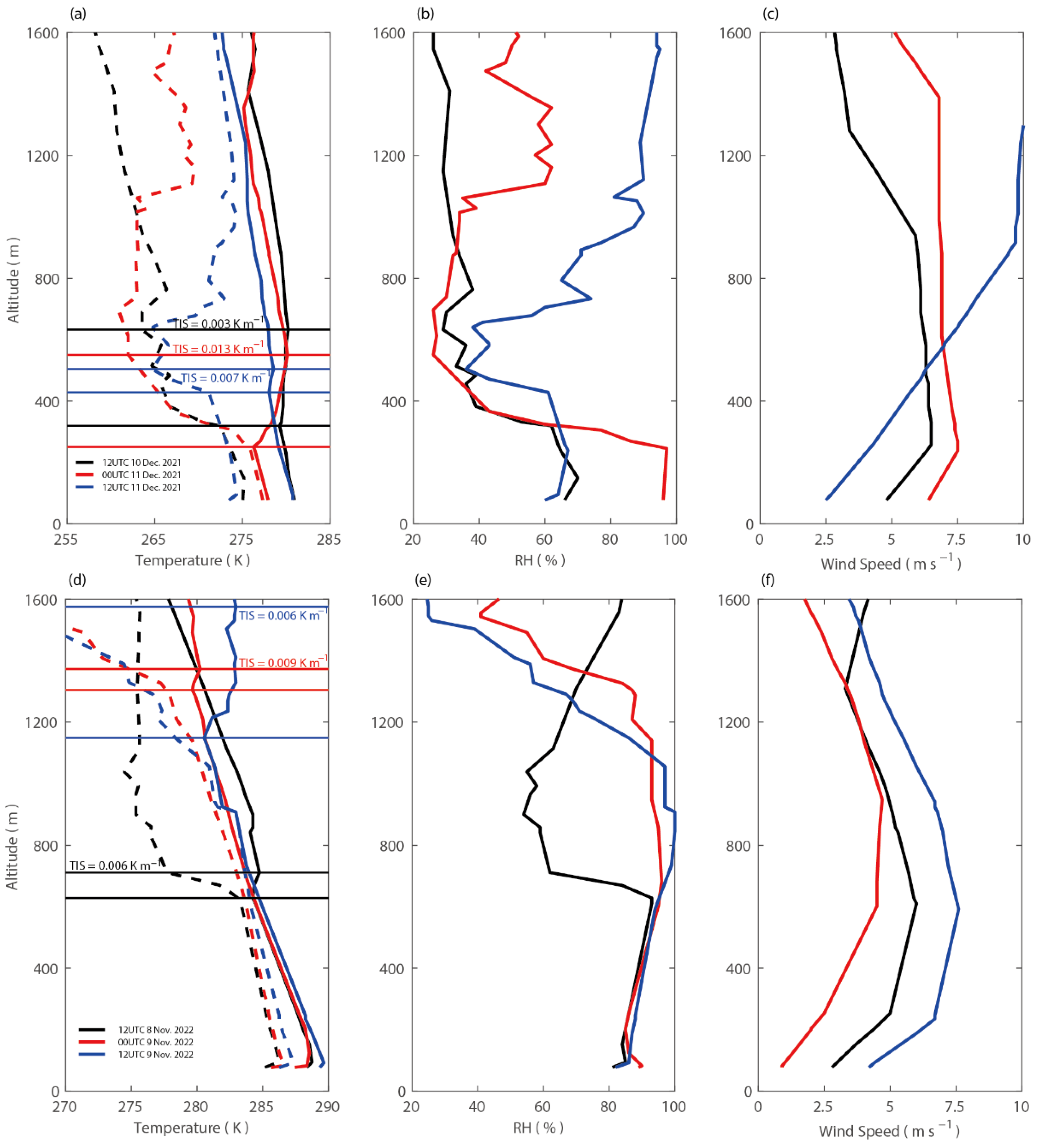

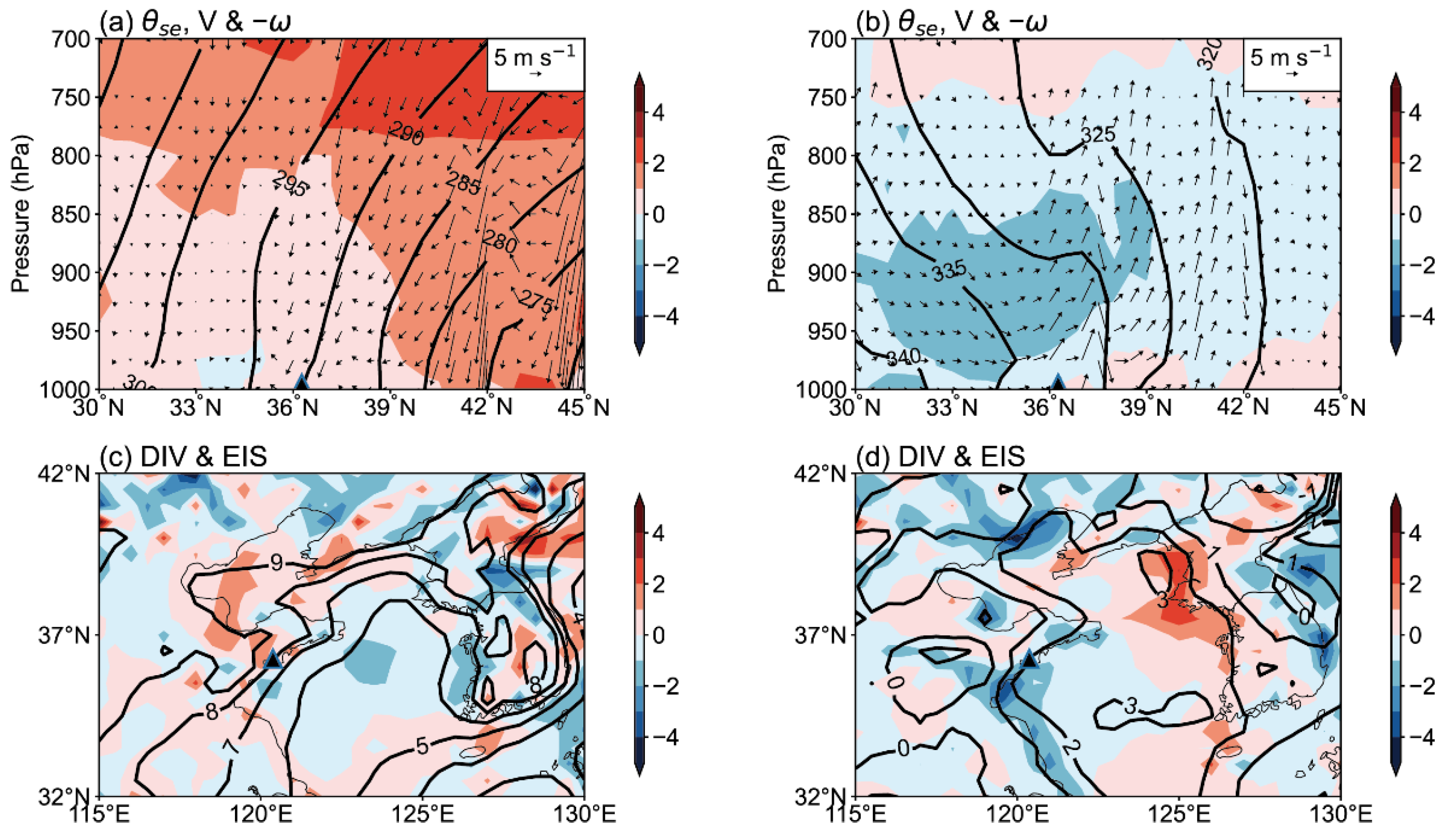
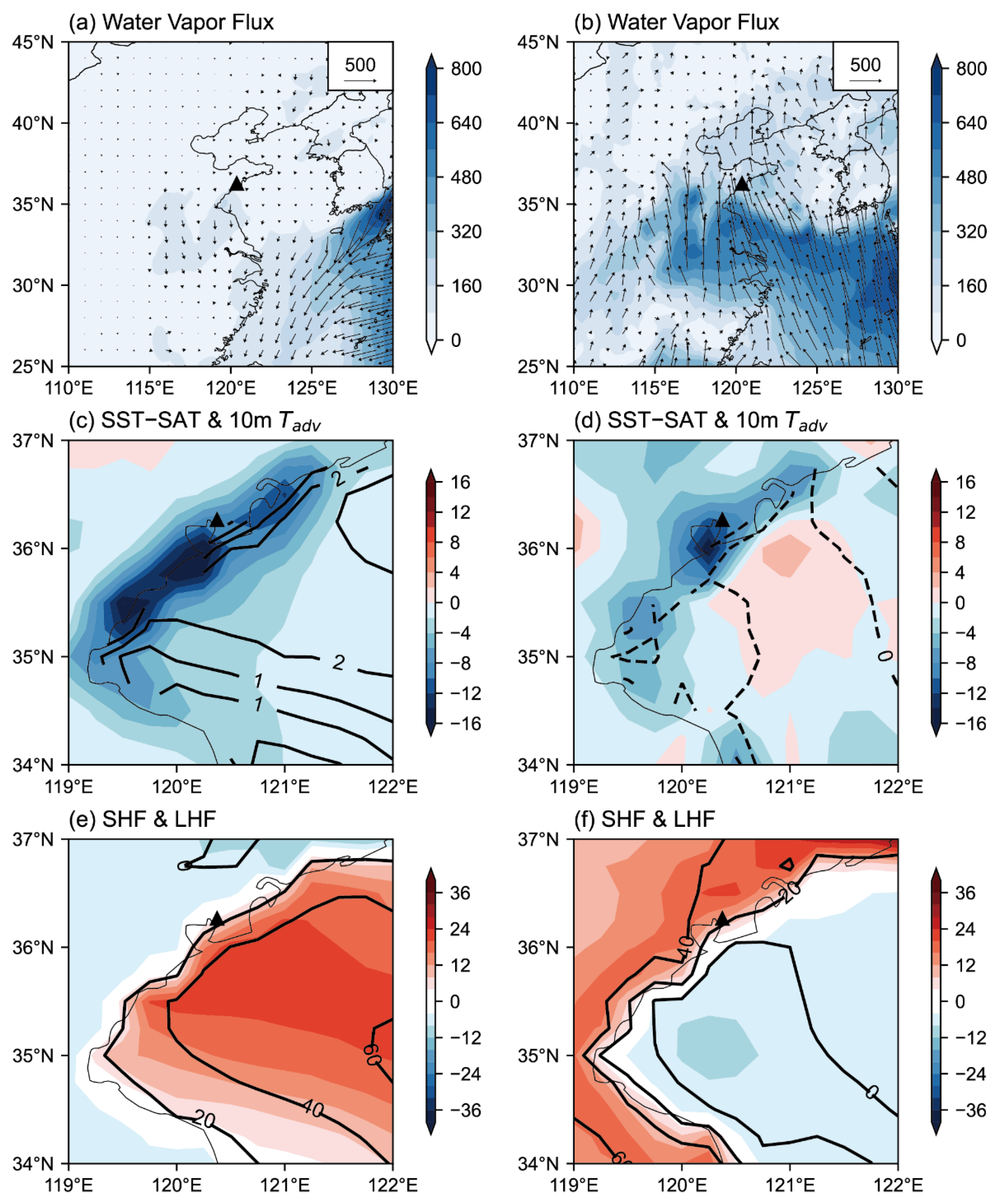
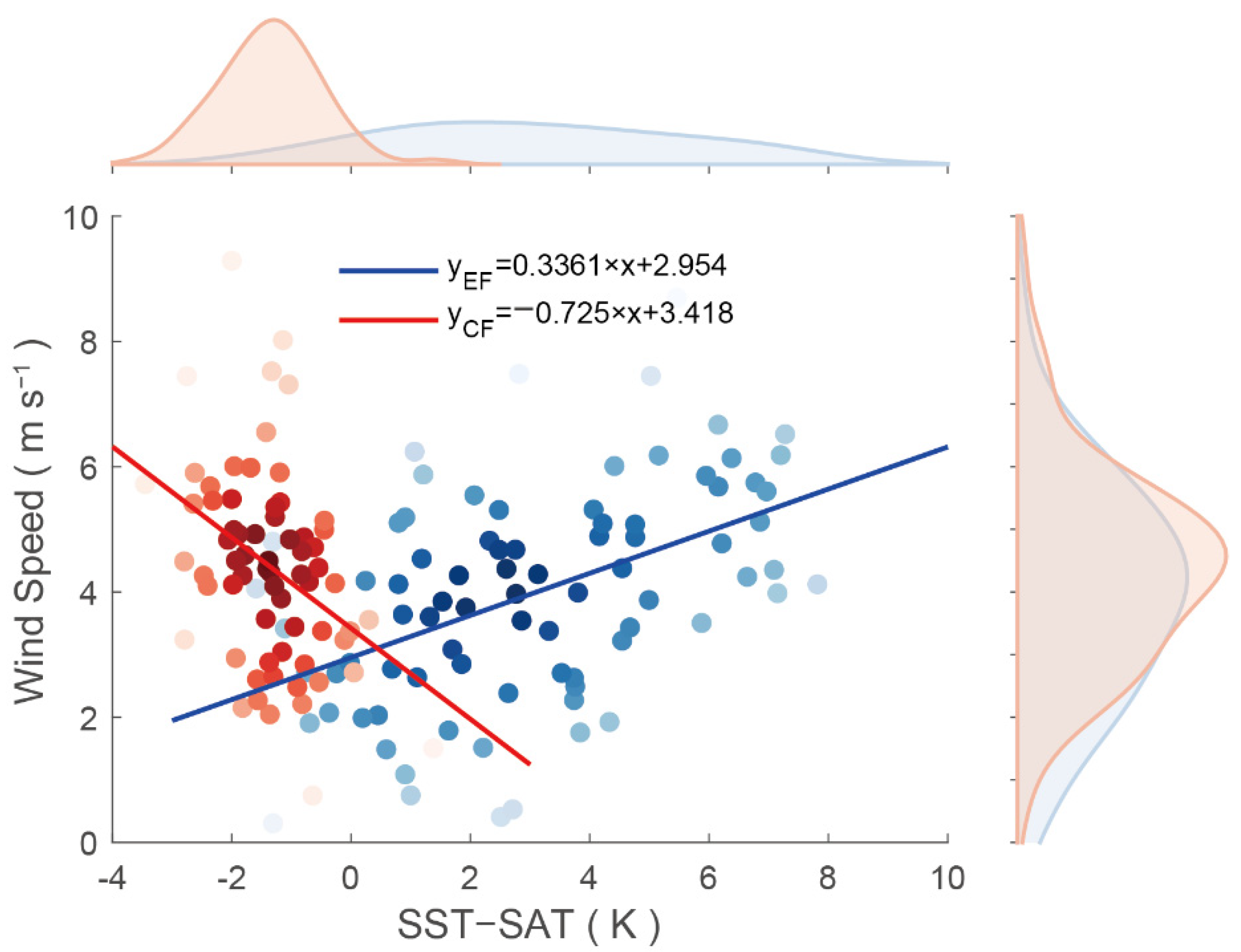
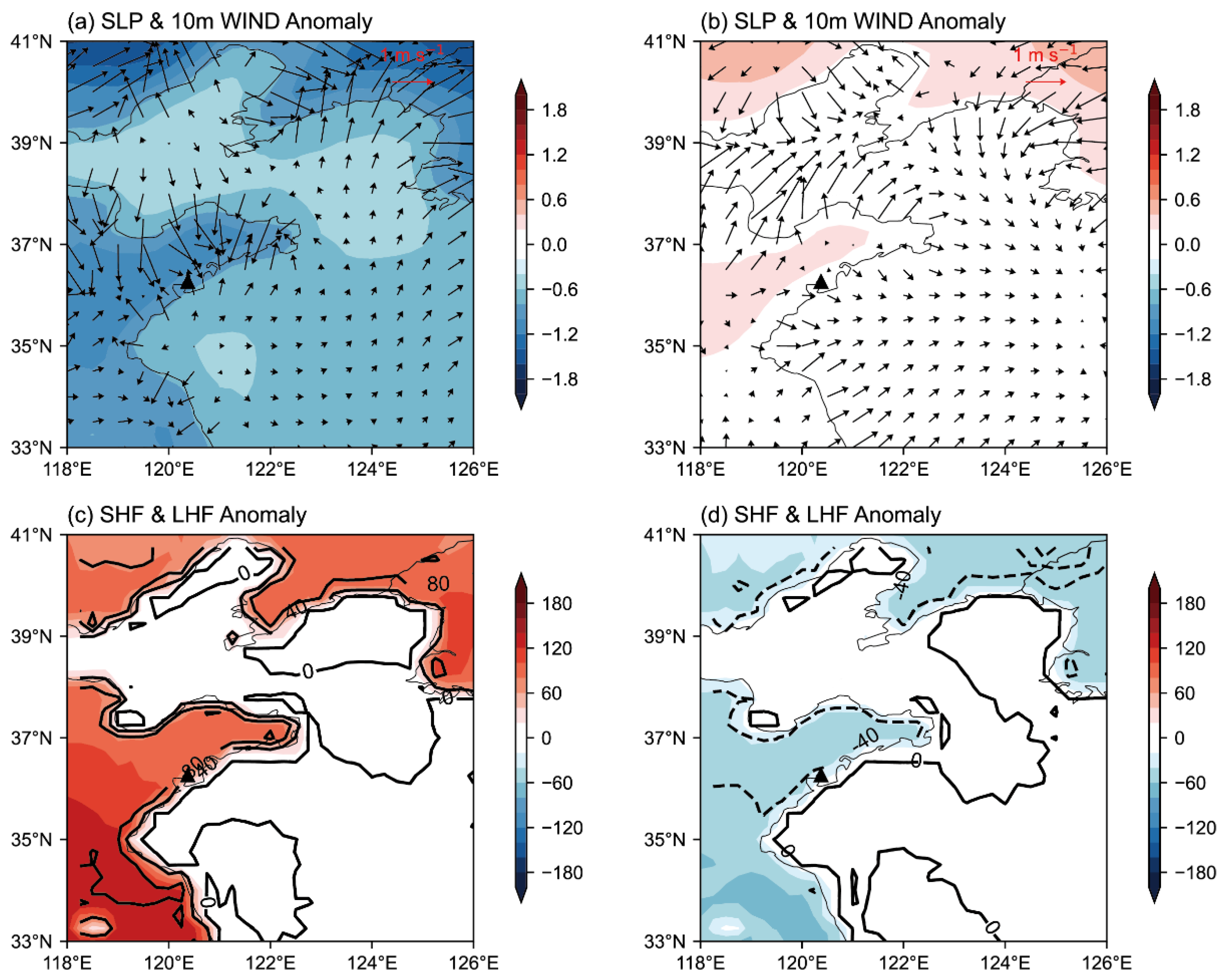
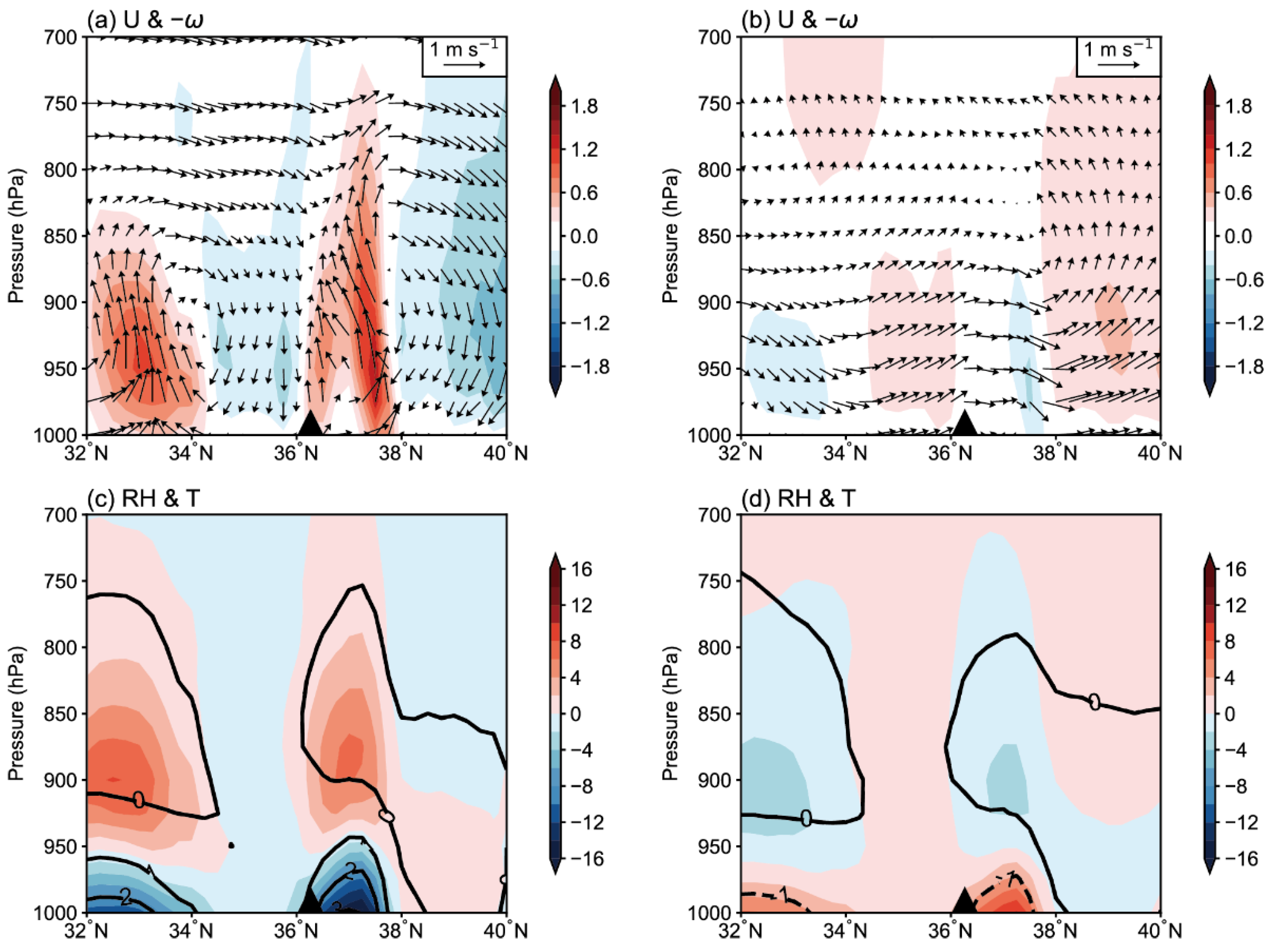
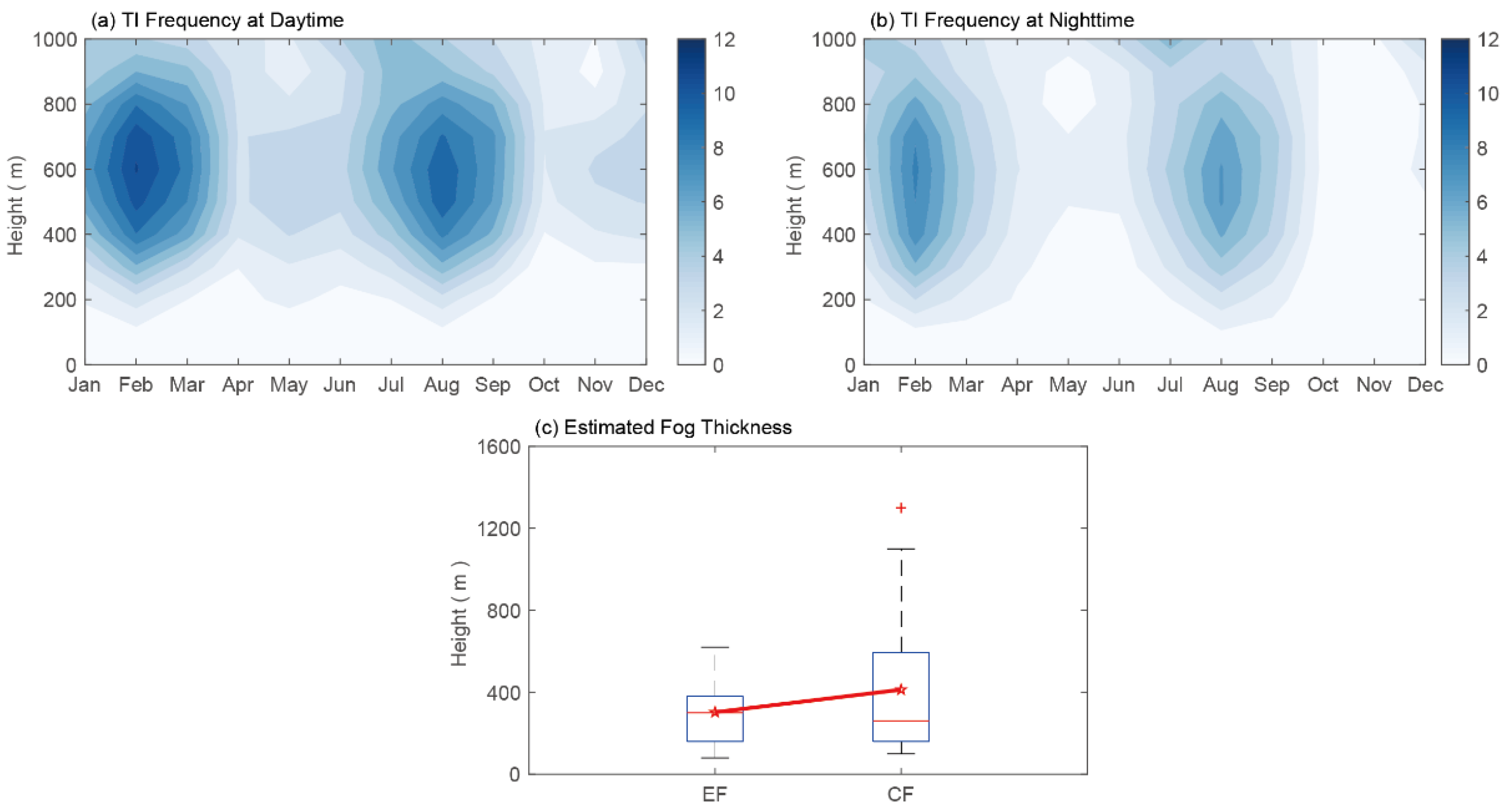
| EF | CF | |
|---|---|---|
| Atmospheric Circulation | Affected by cold and dry air at middle and upper troposphere (even at 950 hPa), surface was affected by cold advection with northwesterly wind | Affected by cold and dry air upon 850 hPa, surface was affected by warm advection with southeasterly wind |
| PBL Stability | Stable | Weak unstable or neutral |
| TI Strength | Stronger | Weaker |
| Thickness | Thinner | Thicker, could reaching 1000 m |
| SST−SAT | Mainly ranged in 0–8 K | Mainly ranged in −4–0 K |
| Surface Heat Flux | Transport from sea to atmosphere | Transport from atmosphere to sea |
| Surface Wind Divergence | Divergence | Convergence |
| Moisture Source | Heat and water vapor flux released by YS | Long-distance transport of moist and warm air from low latitude and local land transpiration |
Disclaimer/Publisher’s Note: The statements, opinions and data contained in all publications are solely those of the individual author(s) and contributor(s) and not of MDPI and/or the editor(s). MDPI and/or the editor(s) disclaim responsibility for any injury to people or property resulting from any ideas, methods, instructions or products referred to in the content. |
© 2023 by the authors. Licensee MDPI, Basel, Switzerland. This article is an open access article distributed under the terms and conditions of the Creative Commons Attribution (CC BY) license (https://creativecommons.org/licenses/by/4.0/).
Share and Cite
Zhang, Z.; Li, Y.; Li, L.; Zhang, C.; Sun, G. Characteristics of Advection Fog at Qingdao Liuting International Airport. Atmosphere 2023, 14, 1310. https://doi.org/10.3390/atmos14081310
Zhang Z, Li Y, Li L, Zhang C, Sun G. Characteristics of Advection Fog at Qingdao Liuting International Airport. Atmosphere. 2023; 14(8):1310. https://doi.org/10.3390/atmos14081310
Chicago/Turabian StyleZhang, Zhiwei, Yunying Li, Laurent Li, Chao Zhang, and Guorong Sun. 2023. "Characteristics of Advection Fog at Qingdao Liuting International Airport" Atmosphere 14, no. 8: 1310. https://doi.org/10.3390/atmos14081310
APA StyleZhang, Z., Li, Y., Li, L., Zhang, C., & Sun, G. (2023). Characteristics of Advection Fog at Qingdao Liuting International Airport. Atmosphere, 14(8), 1310. https://doi.org/10.3390/atmos14081310






